Of all the Provençal Christmas traditions that Mr. TWS and I learned about during our France trip last December, the santons (“little saints”) impressed us the most. We came away with an appreciation for the art and craft of these clay figurines created by local artists (santonniers) and for their importance in the culture as a tradition passed down through generations. Santons were initially the principal characters in nativity scenes (crèches), but as the tradition evolved they came to also depict many characters and scenes of everyday life in 19th-century Provence.
On our first night in Provence, we walked around the Foire aux Santons, an annual fair and market on the old port of Marseille specifically for showcasing santons.
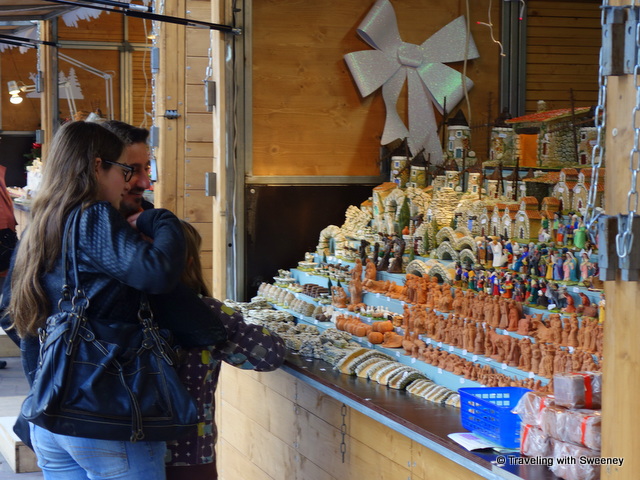
A family in Aubagne peruse santons at a Christmas market
Before our trip, we learned about the tradition of families each year choosing just one figurine to add to their crèche or Christmas display. At fairs and markets in Marseille and in other cities, we were able to observe the tradition in person for the first time. It was very touching to see families carefully reviewing the offerings, choosing the finalists, and then purchasing the new treasure for their collection. The ritual was serious business, but also a lot of fun. It was delightful to see children excited and involved in the process – a nice contrast to focusing on a Christmas wish list of presents for themselves.
In family homes and public displays, santons are included in both Christmas crèches and village scenes. We found it interesting that the secular santons are placed in Christmas crèche along with the religious figures.
In sizes ranging from 2 cm to 25 cm, santons come in differing styles, lifelike and abstract, and clothed in traditional attire (whether an integral part of the clay figure or using real cloth costumes). Most santons are painted, but for those who want to use their own artistic skills, plain terra cotta figures are also sold. The range of occupations represented in Provençal santons is wide and varies by location to showcase local occupations or characters of the 19th century including bakers, butchers, fishermen, priests, singers, nurses, gypsies, and many more. Most people with whom we spoke had a favorite character, and for many it was the village fool — Le Ravi.
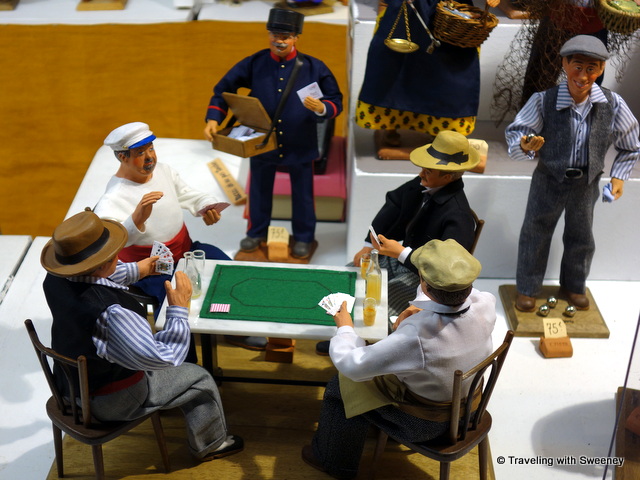
Santons depict scenes from everyday life in Provence
In Arles, we toured the 57th International Fair of Santon-Makers an annual event focusing on the works of professional European santonniers. (In 2015, its 58th year, the fair will run from November 14 to January 10.) Philippe Brochier, the president of the fair’s assocation gave us a tour of the gallery showcasing the santon creations of two distinguished featured artists, Liliane Guiomar and Henri Vezolles (whom we met).
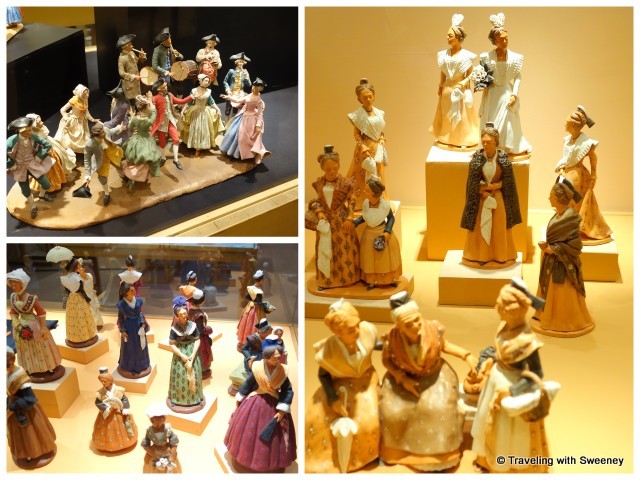
Santons created by Liliane Guiomar (top left) and Henri Vezolles (bottom left and right) and at International Fair of Santon-Makers in Arles
Some of the most amazing santons were those of Mr. Vezolles which were not painted or glazed (such as the ones in the photo above on the right). Instead, he produced an effect of color by using many different types of clay each with a distinctive hue. The intricacy was amazing, and it was hard to fathom the skill and patience needed especially considering that each different clay expands uniquely in the heating process making it hard to avoid breakage.
The fair also includes a competition among amateur santonniers who each submit one work with the winner determined by the votes of visitors. The theme for the 2014 competition was Frédéric Mistral, the beloved Provençal poet who was a leader in promoting and maintaining the region’s traditions and language.
Nativity scenes featuring the baby Jesus, the Virgin Mary, Joseph, and other bliblical and secular santons are prominently displayed in churches and other public locations in the communities.
In l’Eglise des Celestins in Avignon, we admired the crèche shown above with the santon creations of renowned santonnier Marcel Carbonel. Over 600 figurines were displayed in a Provençal landscape with hilltop villages, vineyards, and olive groves.
In Carpentras, a theme is chosen each year for the large crèche displayed in the tourism office which attracts visitors from all over Provence. The 2014 theme was wine, wine-making, and wood trades with an amazing array of santons for the characters.
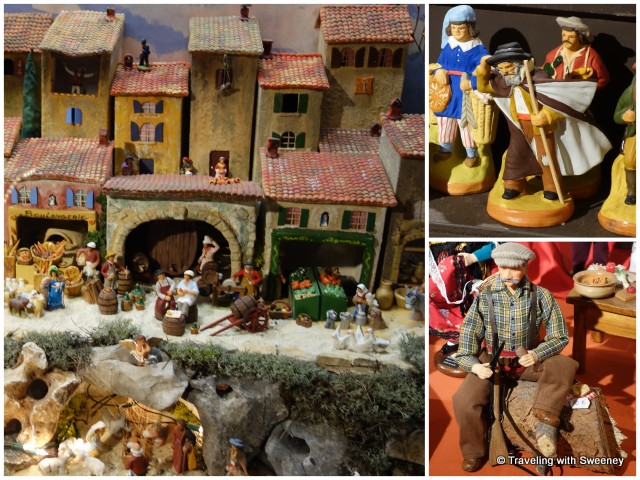
Crèche in the Musée Grévin created by Henri Angiolini (left) and santons at fair (right) in Salon-de-Provence
In the photos above from Salon-de-Provence, the santons on the right were on display at the santon fair at Salle Robert de Lamanon au Septier, inlcuding one of Provence’s beloved Mistral (top right). The photo on the left captures a section of a crèche created by Henri Angiolini installed at the Musée Grévin. The entire crèche took Mr. Angiolini over 2,000 hours to make.
Thérèse Neveu, considered to be the first modern santonnier, is honored in the city of Aubagne (known as the capital of earthenware) at La Cite de l’Art Santonnier, a museum and gallery showcasing Provençal santons and ceramics from around the world. Neveu is credited with inventing the technique of firing santons to make them more resistant to breakage.
Santons and other Christmas traditions are among the many reasons that make mid-November through December a great time to visit Provence.
More to come about Christmas traditions of Provence.

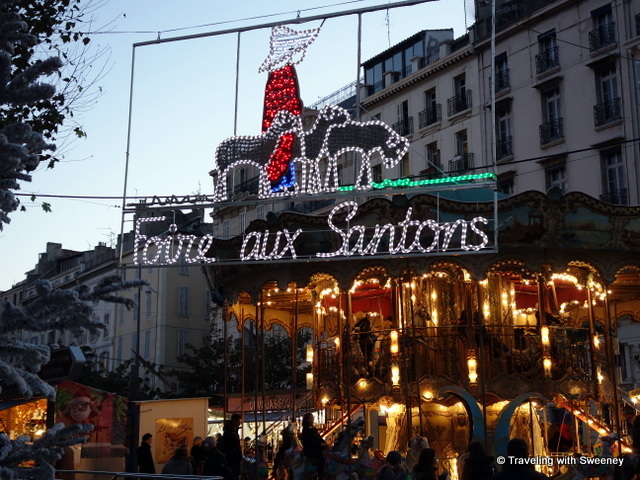

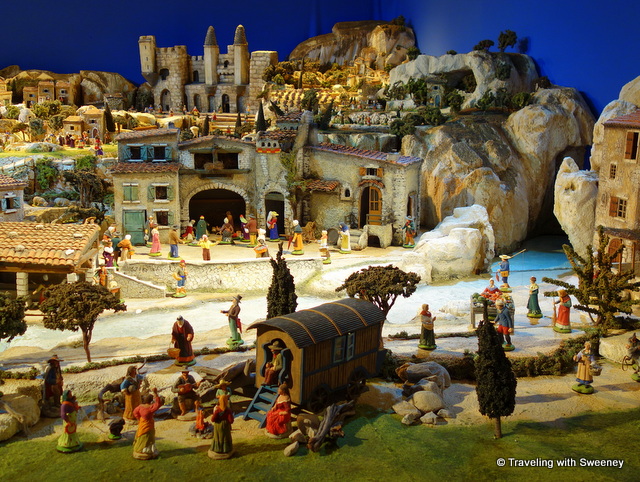


Very cute. Did you get any santons to take home?
Yes, we did bring home a few santons — for ourselves and for gifts. Can’t wait to bring them out this Christmas.
I would call this post cute if I may. This is such a lovely tradition! I wish I visited this town at least once in a Christmas time. This must be a very nice experience!
Yes, you may call it “cute”, Agata. But even more than that, and so wonderfully surprising, is how important the santons are in the culture. And the making of them is truly an art.
Pingback: Christmas Traditions in Provence - Traveling with Sweeney